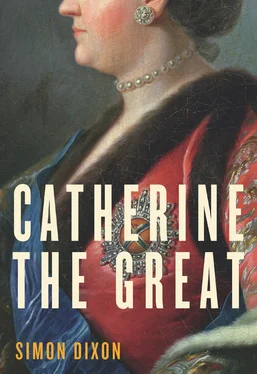Once the war with the Turks had finally been settled at the peace of Jassy in January 1792, Catherine herself planned to spend more time at the Tauride Palace. Though at first she was conscious of the shade of her late partner, it was convenient, as she grew less mobile, to have everything on one level, right down to the pond for the summer sanctification ceremonies. ‘This palace is the height of fashion,’ she boasted to Grimm in 1794, ‘since it is all on the ground floor, with a large and beautiful garden, right in the middle of the barracks on the bank of the Neva, the cavalry to the right, the artillery to the left, and the Preobrazhensky [Guards] behind the garden. There is nowhere better for the spring and autumn.’ 56Designed by Ivan Starov in the restrained neoclassical style she had come to prefer, there was nothing modest about the palace’s dimensions: as an English visitor remarked in 1790, its apartments were as ‘immense’ as Potëmkin himself. 57The colonnade hall in which he had entertained the empress in April 1791 was reputed to be the largest in Europe. The prince had dined in the semicircular bow at one end while his orchestra played at the other; the empress preferred to eat in the centre of the room. 58From there she could see into Gould’s Winter Garden, beyond the temple containing Fëdor Shubin’s statue of Catherine the Legislatrix. Having lost none of her enthusiasm for building, she commissioned a Palladian villa for Gould in the palace grounds in 1793. 59But before she herself could embark on long periods of residence there, the palace required significant restoration. In January 1793, Catherine approved a long list of repairs to be completed by 20 March. The wooden partitions erected in her private apartments the year before were to be strengthened; beams were to be replaced ‘in all those places where danger is most foreseen’; the porcelain stoves were to be stripped to their foundations so that the panels behind them could be replaced in brick to prevent a conflagration; and all ‘doubtful places’ near the theatre were to be reinforced. Further work, including a safety inspection of the cupola, was planned for the summer while the Court was at Tsarskoye Selo. 60
The structural deficiencies that Catherine strove to correct at the Tauride Palace were not so different from the ones she mocked in her description of Elizabeth’s draughty residences in the final version of her memoir, written in 1794. But this was a text designed to highlight contrasts rather than similarities between the two eras. In later life Catherine liked to boast how much more orderly her own Court had become by comparison with the chaos she had experienced as a grand duchess (failures of protocol on the part of her officials were treated with corresponding severity). 61Modelled on Plutarch’s Lives , her memoirs pursued the same theme in more subtle form. Platon Zubov had been obliged to construe Plutarch with her while waiting for news from the Danube in the spring of 1790, when they translated his biographies of Alcibiades and Coriolanus (‘it fortifies my soul’). After that, the author first recommended to her by Count Gyllenborg in Hamburg was never far from her mind (in February 1796, an eighteen-volume edition of his works was among her last purchases for her library at Tsarskoye Selo). 62Plutarch’s pairing of lives of the great men of ancient Greece with those of ancient Rome suggested to Catherine a way of comparing herself with her murdered husband. Like her classical mentor, she concentrated primarily on questions of character and personal virtue, implying that she, and not Peter III, was the worthier successor to Elizabeth. 63
Unable to read her confidential memoirs, contemporaries struggled to match Catherine’s claims to orderliness with the reality of Russia in the early 1790s. Though it came as no surprise at the end of a degenerative illness that had rendered him ‘useless for four years’, the death of Prince Vyazemsky on 8 January 1793 significantly destabilised her regime. ‘You can’t imagine what a state he’s in,’ Catherine had warned Zubov after seeing her ailing Senate Procurator in 1792. ‘As he says himself, he neither eats nor sleeps. His heart races almost continually; his head is so weak that it drops on his shoulder when he sits down; seated in his chair, he rocks from side to side out of feebleness; he says that every movement is unbearable and that fresh air leaves him breathless.’ 64Such was the nature of Russia’s patronage system that Vyazemsky’s demise signalled far more than the loss of a single experienced administrator. Between the onset of the prince’s illness in 1791 and his death, nearly half the empire’s senior provincial offices changed hands. The political implications of this merry-go-round were all the more unsettling because Catherine’s reforms had left provincial bodies responsible for many of her government’s most important functions. And among her newly appointed provincial governors and their staff were men who had begun to wonder where the new centre of gravity would lie in the absence of Vyazemsky and Potëmkin. 65
If some of them understandably looked sidelong towards Gatchina, where Grand Duke Paul was waiting impatiently in the wings, the one thing that united most prominent courtiers and officials was the conviction that Platon Zubov was unsuited to fill the void. Since an age gap of thirty-eight years between the empress and her favourite was bound to excite comment, John Parkinson found the Russian capital alive with prurient gossip in 1792–3. This was the atmosphere in which the fabulist Ivan Krylov could venture to publish (anonymously) suggestive verses about ‘The dying coquette’ that owed something to the libertine tradition of pornographic journalism rampant in late eighteenth-century France. 66But if Catherine’s increasingly desperate search for comfort and companionship threatened to desacralise the monarchy, Zubov’s inflated ambitions were even more damaging to her reputation. While she tirelessly advertised his virtues to Grimm, St Petersburg remained unconvinced. Ivan Shuvalov, the leading influence behind Russia’s cultural efflorescence in the late 1750s, had shown what could be done by an intelligent favourite operating under the aegis of an ailing empress. Zubov was a mere cipher by comparison. Here was an avaricious upstart who had achieved nothing and yet pretended to everything. Making a pun on ‘ zub ’, the Russian word for tooth, Potëmkin had likened Catherine’s latest protégé to an irritating molar that ought to be removed. Released from his rivalry with Potëmkin, whose enemy Saltykov became Zubov’s firmest ally at Court, the new favourite interfered in both domestic and foreign policy, relentlessly acquiring offices in the army and New Russia in a vain attempt to inherit the master’s mantle. On the day before her sixty-seventh birthday in 1796, Catherine rewarded his service to the state with 100,000 roubles; in January 1792, she had given him his own chancery; he even held his own elaborate lever in his palace apartments. ‘This Zeuboff has the character of being an active little man,’ Parkinson remarked, ‘who however behaves with no small degree of hauteur, which in a person from the dust as he is gives no small offence.’ 67
The exposure of the corrupt Court banker in 1791 symbolised the cracks that had begun to open up in Catherine’s administration. Living in style on the English Line as the scion of a prominent shipbuilding family, Richard Sutherland had acquired a reputation for wheeler-dealing that led Catherine to trust him with her finances and invest him, as she had Dr Dimsdale, as a baron of the Russian empire in 1788. Three years later, when she began to hear complaints about his activities, Derzhavin, whom Zubov had helped to appoint as one of her secretaries, was ordered to investigate. Frustrated to discover that almost all the leading figures in the government were as indebted to Sutherland as he was himself, Derzhavin was unable to complete his inquiry before the banker died on 4 October 1791, the day before Potëmkin. Nevertheless, a further probe in the following spring revealed that he had embezzled more than 2 million roubles. The prince, who had been borrowing from Sutherland since 1783, owed 800,000; Zubov’s influential protégé, Arkady Morkov, owed 42,000; Vyazemsky and Grand Duke Paul were also deeply in debt. Infuriated by her son’s behaviour, Catherine had no option but to order the treasury to absorb the largest debts. 68
Читать дальше












